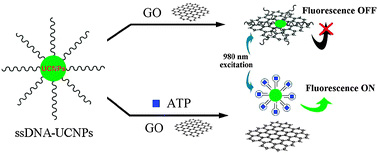Graphene oxide (GO) plays a crucial role in a new, sensitive biosensing platform, acting as an efficient quencher for upconversion nanophosphors, say scientists in China.
Zhengping Li, Chenghui Liu and colleagues from Hebei University, have constructed a sensitive and practical biosensing platform by combining lanthanide-doped upconversion nanoparticles (UCNPs) with single-stranded DNA (ssDNA). Upon the addition of water soluble GO the upconversion fluorescence is quenched, effectively turning ‘off’ the fluorescence signal. To test the platforms sensing ability and performance, the team introduced adenosine triphosphate (ATP) resulting in the formation of an aptamer-ATP complex, preventing the UCNPs interacting with the GO surface and thus decreasing the quenching efficiency, resulting in the fluorescence staying ‘on’. Other phosphates were tested, like guanosine triphosphate (GTP), cytidine triphosphate (CTP) and uridine triphosphate (UTP) but no dramatic fluorescence enhancement was observed, so this indicates that the aptamer system is specific to ATP alone.
Interestingly, the team also tested the biosensing platform with mercury ions, which caused the ssDNA to form double-stranded DNA (dsDNA), preventing the UCNPs interacting with the GO surface and again resulted in enhanced fluorescence emission. Other similar cations were tested in comparison, but the biosensor only shows selectivity for mercury ions, providing a good indication into the high specificity that this biosensing platform has, in addition to its future potential for uses in clinical diagnostic and biosensing applications.
Fancy finding out more? Then why not download the communication today – published in ChemComm, the article has been made free to access until the 13th May 2011.
Please also let us know what you think to this research by blogging some comments below.











